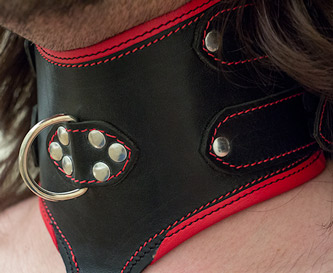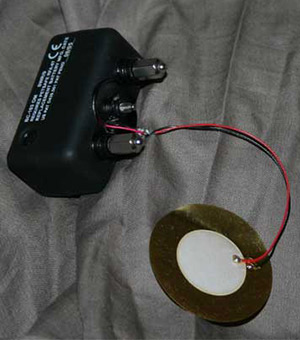
This posture collar came with my first pony play harness (the chest harness actually attaches to this, putting additional pressure on the neck with every movement) Photo by cpony.com

This posture collar came with my first pony play harness (the chest harness actually attaches to this, putting additional pressure on the neck with every movement) Photo by cpony.com
Collars are often used in ponyplay even though one might suspect that they would be more suited to puppy play. As a BDSM fetish, ponyplay will inevitably incorporate some BDSM equipment not directly related to ponyplay. In ponyplay, a pony can be led around by the reins, which can be attached to a bit or a halter, so the utility of a collar to lead a pony around is somewhat redundant.
Nevertheless, collars do look nice on a pony, and can still be used for the purposes of attachment, such as in cases when attachment via the reins would be inappropriate. Collars can also be used as part of a pony's harness to give an added aesthetic appeal. Posture collars are also somewhat prevalent on ponies since they force the pony to carry his/her head up, and they are an added degree of restraint on the pony's movement. I will not go into all the different collars available since there are far too many. Collars are a very common piece of equipment in BDSM, and a wide selection can be found at nearly every fetish and BDSM shop.
There is also the shock collar, which again might be more suited to puppy play, but I have found it to be a great utility in ponyplay because it can be used to prevent a pony from making non-equine sounds. Of course, an ordinary shock collar can be used in training the pony. They can be especially useful if the pony is, say, a jumping pony and the trainer does not wish to jog or run with the pony around a jumping course to correct any mistakes. In such a situation the trainer could remain in one place and administer a shock to the pony from a distance if the pony makes a mistake on the course.

A modified bark collar. The larger piezo is much more sensative to sound than the standard collar. Photo by cpony
As I mentioned above, a shock collar, or more specifically, a bark collar, can be used to prevent, or at least discourage, any non-equine sounds. A horse's whinny is a relatively high frequency sound with various modulations. I thus devised a method to modify a commercially available electronic bark collar such that it would deliver a shock for any vocalizations that were of a lower frequency than a typical whinny. It turns out that everyday speech is significantly below this frequency range, and it is quite difficult to produce words in the whinny frequency range. Thus, the end product effectively delivers a shock for any sounds that are not equine in nature.
The system is still being revised so that it will ultimately have a bandpass, allowing the lower frequency nickers and snorts as well as the high frequency whinny. Further down the line I expect to advance the system such that it will not allow any attempts at high frequency speech (it's quite effective at preventing that now, but with some more advanced modifications it will only allow equine sounds).
Anyway, the piezoelectric transducer has to be on the neck to record the sounds, but it can easily be hidden under (and/or integrated into) a collar. However, the shock does not have to be delivered to the neck area; it is trivial to connect a wire to the device which would deliver the shock to any part of the body (genital area seems the best).